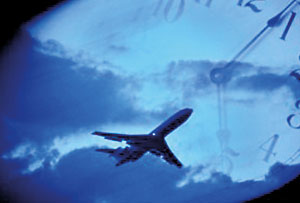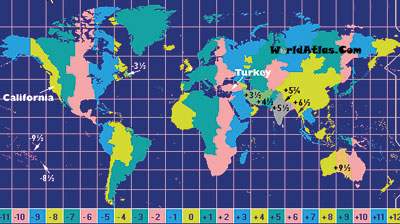Anyone can get jet lag, regardless of how often they travel by plane. Jet lag may last several days, and a recovery rate of one day per time zone crossed is a fair guideline.
When Asian subcontinent cricketers go to England to play cricket, some may require five days to shed the jet lag and probably one-two days longer for Australia. Just because you played well in the IPL (Indian Premier League tournament) two days before, it does not mean that you will carry your form to a different time. In fact, the converse is probably true as your concentration and judgement are affected. Sometimes jet lag may hit you hard only after two or three days!
Why does this happen? The earth revolves round its own axis every 24 hours, giving us the 24 hour day with approximately 12 hours daylight and 12 hours darkness, in the equatorial countries.
However, the body clock is longer and closer to 28 hours, and has to ‘synchronise’ and work harmoniously with the world clock, even when there is discrepancy resulting from travel across time zones.
As the earth is rotating, different countries receive daylight or the first rays of the sun at different times. A time zone is a longitudinal, geographical region which has the same time everywhere within it. The world has 24 time zones, one for each hour in the day. Each zone runs from north to south in strips that are approximately 1,000 miles (1,600 kilometres) wide.
(The actual width of each zone varies to accommodate political and geographical boundaries.) As the earth rotates, dawn occurs at a set hour in one time zone, then an hour later in the time zone immediately to the west and so on through the 24-hour cycle. Thus, in the U.S., when it is 6 a.m. in the Eastern Time Zone, it is 5 a.m. in the Central Zone, 4 a.m. in the Mountain Zone, and 3 a.m. in the Pacific or western time Zone
Time zones
The body clock is designed for a regular rhythm of daylight and darkness, so it's thrown out of sync (synchrony) when it experiences daylight and darkness at the 'wrong' times in a new time zone.
Jet lag results from rapid long-distance trans-meridian (east–west or west–east) travel, as on a jet plane.
Does the direction of travel matter?
Yes, it does and significantly so. Travellers flying north or south in the same time zone typically experience the fewest problems because the time of day always remains the same as in the place where the flight originated. The condition is not linked to the length of flight, but to the trans-meridian (west–east) distance travelled.
When you travel westwards and increase the day and day light hours, by about four hours, it is like ‘breaking rest’ for a dance or party. Travellers flying east, on the other hand, typically experience the most problems because they have a shorter day which is difficult to adjust to, as there is no comparable situation in regular life. For example, on an international flight from Washington, D.C. or New York to Sri Lanka, a traveller loses ten hours. Meals, sleep, bowel habits, and other daily routines are all pushed ten hours ahead or more.
Travellers flying west "gain" time and usually have an easier time adjusting than eastward travellers. However, they too experience symptoms of jet lag after landing because they still must adjust to a different schedule. Comfort in the air may provide a more restful sleep on board but does not minimise jet lag.
Crossing the International Date Line does not contribute to jet lag, as the guide for calculating jet lag is the number of time zones crossed, and the maximum possible disruption is plus or minus 12 hours. If the time difference between two locations is greater than 12 hours, subtract that number from 24. Note, for example, that the time zone GMT +14 will be at the same time of day as GMT -19, though the former is one day ahead of the latter.
The world clock, body clock, melatonin and jet lag
To help the body tell the time of day, fibres in the optic nerve of the eye transmit perceptions of light and darkness to a timekeeping centre within the hypothalamus. After the sun sets, the eyes perceive darkness and alert the hypothalamus to begin releasing melatonin from the pineal gland, which promotes sleep. Conversely, when the eyes perceive sunlight, they tell the hypothalamus to withhold melatonin production.
The hypothalamus, which is important for memory, acts like an alarm clock, to activate various body functions such as hunger, thirst, and sleep. Melatonin is a hormone that plays a key role in body rhythms and jet lag. However, the hypothalamus cannot readjust its schedule instantly; it takes several days. Thus, when the eye of an air traveller perceives dawn or dusk many hours earlier or later than usual, the hypothalamus may trigger activities that the rest of the body is not ready for, and jet lag occurs.
Melatonin is present in the bloodstream naturally in differing amounts according to the time of day. It is produced by the pineal gland in darkness; secretion stops when there is light to the eyes.
Your biological clock is usually synchronised with your local time so that you feel hungry in the morning and sleepy in the evening. However, after travelling across time zones, your body takes a while to adjust to a new daily routine. The speed at which the body adjusts to the new schedule depends on the individual; some people may require several days to adjust to a new time zone, while others experience little disruption.
Adjustment is the key word when it comes to jet lag. The problems that arise with jet lag are a clear example of how external influences can disrupt your internal body clock which determines the quality of your life.
A summary of the role your internal clock plays, includes :
- Your sleep/wake cycles.
- How refreshed you feel in the morning.
- How easy it is for you to fall asleep at night.
- Whether you can recover quickly from jet lag.
- The fate of a shift worker who has to be productive at odd hours.
- Whether you’re a lark or an owl.
- Your mood and energy level.
- The strength of your immune system.
Minimising jet lag
Night or day flight?
It is largely a matter of personal preference based on experience. Most travellers think daytime flights cause less jet lag and in fact, more daytime long haul flights are being added by major airlines.
One option to counteract jet lag is to break the trip into smaller segments and stay overnight in a city where you can comfortably merge into that time zone. Additionally, it may be advisable to adjust sleeping hours on the plane to match the destination time.
Before you travel - Top up your sleep
Avoid embarking late at night or in the early hours of the morning which will mean that you embark on the flight tired and not rested. Avoid long or tiresome transit stops.
Change your sleep routine
A few days before you travel, start getting up and going to bed earlier (if you're travelling east) or later (if you're travelling west). During the flight, try to eat and sleep according to your destination's local time. This is possible as the time at the destination is now shown on the flight monitor on your screen.
During the flight - Sleeping aids
Blindfolds, ear plugs, neck rests and blow-up pillows are all useful in helping you get quality sleep.
Exercise
Get as much exercise as you can. Walking up and down the aisle, standing for spells, and doing small twisting and stretching exercises in your seat all help to reduce discomfort, especially swelling of legs and feet, and preventing deep vein thrombosis (DVT). Get off the plane if possible at stopovers, and do some exercises or take a walk. This also helps to reduce the possibility of blood clots.
Hydration
To avoid dehydration avoid alcoholic beverages and caffeine. Instead drink plenty of water to help counteract the effects of the dry atmosphere inside the plane.
.Avoid a prolonged nap at the time you feel drowsy (presumably at the time that you would have been asleep in the time zone departed from) as it simply anchors the rhythms at their former phases and so resists the adaptations to the new time zone.
Young people have a better tolerance to de-synchronization of rhythms, owing to a better regulation of biological clocks. Physical fitness also seems to play a role: active subjects demonstrate higher amplitudes in existing rhythms than age-matched controls, a difference indicative of superior regulation.
But other than these factors, there has been little success in attempting to predict good and poor adapters to long haul flights. Furthermore, the fact that an individual escapes lightly from symptoms on one occasion is no guarantee that he or she will do so again on the next flight.
Preventing jet lag
Interestingly there is a website which ‘guarantees’ avoidance or minimising jet lag if you provide the itinerary by:
- Telling the correct time for you to rest or to stay active and when it's possible for you to get core sleep given the limitations of your specific flight schedule.
- The optimal time during your trip to switch your behaviours to the new time zone.
It may be worth the charge of $35 if it works!
|



